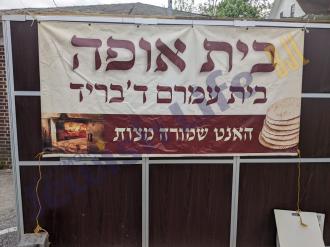A few days before Sukkot about two years ago, my husband brought home his prized etrog.
I know he spends time searching for just the right one and is always excited to return with his “find.” Good wife that I am, when I opened the box to take a peek at the fruit, I immediately critiqued his selection. “What? You call that beautiful?” I inquired delicately. “It is all lumpy, a little heavy on the bottom, has ridges down the side and a greenish tint.” With perfect patience and a wry smile, he replied that, “you simply don’t know the definition of beauty. It isn’t what you think is attractive… it’s the Torah’s definition of what makes an etrog ‘mehudar.’ These ridges, lumps and particular shape are actually the optimal features for a beautiful etrog.”
After I quickly changed the conversation (and determined to make jelly out of that yellow specimen in the not-too-distant future), the fascinating analogies to relationships suddenly hit home. At the YUConnects office at Yeshiva University, our educational programs include guiding young adults on values that will lead to long-term healthy relationships. We engage in vibrant discussions on important attributes to seek in a spouse, offer counseling in deciding “the right one,” and cultivate lessons for maintaining shalom bayis (marital harmony). There were clearly striking correlations to the esteemed etrog.
If anyone has been to the market in Mea Shearim Erev Sukkot, or similar markets worldwide, they would witness thousands of pious Jews scrambling in their quest to select beautiful kosher arba minim, with a prime focus on finding the “perfect etrog.” Some people wait until the last minute, some are overly picky and others decide to put all their resources and time into the endeavor.
Certainly, not all analogies drawn from the halachic and historical research will apply to long-lasting relationships; we do not recommend slicing and sharing a spouse with the rest of the community, nor do we “posul” (invalidate) an individual for a birthmark on their upper torso!
Still, the holiday of Sukkot is replete with comparisons to the loving relationship Hashem has with Bnei Yisrael. The sukkah itself is compared to the chuppah. This time of year is the re-igniting of the passion for the observance of the mitzvot after the repentance period of Aseret Yimei Teshuva and Yom Kippur.
With that in mind, pursuit of obtaining the “mehudar” fruit, coupled with general halachic guidelines in the care of the etrog, has lessons for us all. The following observations will make you stop, think, and view the etrog—and hopefully, your spouse—with greater appreciation:
1) Beauty is in the Eye of the Torah—Then the Choice is Yours!
As mentioned, “mehudar”—beautiful features—are defined by the Torah. What may not appear to be important is considered precious if it meets proper halachic ideals.
However, the preferred shape and style vary greatly between cultures. Some notable kinds include the Moroccan classic “hourglass” shaped ridge, commonly called the “gartel,” favored by many Chassidim; the popular Chazon Ish selection that has many ridges; the larger Yemenite kind; and the greener Italian Yanover variety. Each of these is acceptable; each is sought after by different kinds of Jews and ultimately cherished.
So, too, in a search for a spouse there are various characteristics and personalities that are suited for different people. Some qualities should be essentials: honesty, integrity, devotion and compatibility of religious/Torah values. Our sages have offered guidance and taught us about critical qualities that will be important for long-lasting bonds—but they don’t include tablecloth colors or the style of hat. Nonetheless, our particular preference on the actual look, personality or form can certainly vary and we are justified in seeking mutual attraction, lumps and ridges included!
2) Hang in There—Maturity Matters
Another meaning for the word “hadar” is “dwelling,” since the pri etz hadar etrog remains on the tree even after it ripens. Season after season, the etrog endures and doesn’t fall off like other fruits. Part of the etrog’s appeal within the Jewish concept of beauty is the resolve of the fruit to “hang on” and withstand the elements trying to bring it down.[1]
Naturally, maturity in entering a marriage is an essential trait. So is perseverance. When two people commit to matrimony, their personal determination to make it last is a key barometer whether it will stand the test of time. Much like the etrog, admired for its ability to “hang in there,” a crucial criterion for a spouse should be their fortitude to partner together season after season.
3) Fragrance and Flavor
The etrog is also unique in that it has both fragrance and flavor. Unlike the other minim (species), which have none or only one of those characteristics, the etrog contains both qualities and is therefore compared to a person with both Torah knowledge (flavor) and good deeds (fragrance).
When seeking a soul-mate, one certainly should look for the person who will encapsulate both attributes, not just a bright intellectual type. Instead, seek someone who performs “chesed,” acts of kindness. Similarly, an observant Jew cannot rest on his acts alone; everything is based on understanding Torah principles so that a solid foundation will help build a strong Jewish home.
4) The Heart is Where it’s At
Each of the arba minim is also compared to a body part: the lulav is the upright spine, the hadasim are the eyes and the aravot the mouth/lips. While all come together to serve Hashem in this mitzvah, the etrog is the centerpiece—the caring and compassionate heart.[2]
With all that is written about beauty, values and qualities to seek, ultimately it is that inner sensation/emotion that guides one person to another. Let the heart rule; it is usually not wrong.
5) Check out the Roots
Halachic authorities are strict about requiring careful examination regarding the source of the etrog orchards to ensure no cross-pollinization or grafting of the citron tree with other trees. Rabbinical certification that the tree is not “murkav” authenticates that the base of the tree wasn’t grafted with a lemon tree to make cultivation easier.
The parallel to “yichus,” or investigating a family tree, is quite evident. While people should not be overly concerned whether one’s lineage dates back to a particular tzaddik or tradition, research into familial ties and character may uncover clues about a potential spouse which will impact future interpersonal relationships. Though not precise, as the proverb states, “the fruit doesn’t fall far from the tree.”
6) No Microscope Please
When searching for an etrog, it is appropriate to make sure there are no holes or marks, especially on the upper third of the fruit. However, if a mark is visible only via a microscope but not to the naked-eye, the etrog is 100 percent acceptable.[3] “Lo nitena Torah le’mal’achey ha’sharet” (“The Torah was not given to the ministering angels”), means that the Torah’s laws do not demand anything beyond ordinary human capability. Minute imperfections don’t count.
This has many obvious comparisons to relationships. Not only shouldn’t one examine so closely to uncover tiny flaws, but it may not always be best to check, re-check and check again every reference and opinion about a person. No one is perfect and no one benefits by microscopic inspections.
7) Handle with Care
To prevent piercing the rind or breaking off the pitom, an etrog must be handled delicately, wrapped in silken flax or soft foam. Contact with a sharp object can invalidate the etrog and render it useless for the holiday.
Relationships may not be quite as fragile, but that is no reason to proceed with abandon. Words and actions truly pierce the heart and can be very destructive. Even unintended passing remarks can’t be withdrawn, and the resulting hurt may be difficult to mend or can even be irreparable. If only we all would treat our loved ones as well as the etrog in the silver box…
8) Never Too Early to Daven
The Bnei Yissachar[4] cites Chazal who tell us to daven for a beautiful and kosher etrog on Tu B’shevat, when trees first produce sap, many months before Sukkot. He states that the Hebrew phrase in the Mishna, Rosh Hashana 1:1, is “Rosh Hashana l’Ilan” (“the tree”), written in the singular, not “l’ilanot” (“the trees”), to give tribute to the only fruit that is physically used in observance of a mitzvah, the etrog. It is never too early to daven for Hashem’s help in finding the right etrog, even in the winter month of Shevat.
With all the guidelines, research and advice offered on finding a “zivug” (mate), nothing compares to proper davening to the Almighty. Some parents even begin their prayers the moment their child is born since Divine intervention is what ultimately brings two partners together. As Hashem is the matchmaker for us all, heartfelt supplications for the special someone will be heard and answered l’tovah (for good).
May the search for the perfect etrog to honor Hashem be a zechus to find the “perfect-for-you” soul-mate with beautiful qualities both on the outside as well as within.
Mrs. Marjorie Glatt is a Special Projects Coordinator at YUConnects
YUConnects is at the forefront of offering today’s generation more opportunities than ever through combining the best in technology advances with a warm, personal touch. Housed at Yeshiva University’s Center for the Jewish Future but OPEN TO ALL and self-funded, YUConnects’ friendly office provides relationship guidance, academic research, targeted matches and unique social events
500 W 185th Street
Furst Hall, Yeshiva University
New York, NY 10033
YUConnects@yu.edu
212-960-5400 ext 6163
[1] See R. Joshua Shmidman, “The Etrog: Jewish Beauty and the Beauty of Jewishness,” Jewish Action (Sept. 26, 1997), available at: www.ou.org/jewish_action/09/1997/the-etrog-jewish-beauty-and-the-beauty-of-jewishness.
[2] Vayikra Rabbah 30:14
[3] Y.M Stern, The Halachos of the Four Species, p. 22, Feldheim Publications, 1993
Excerpted from YU Torah-To-Go Sukkot 5774
















